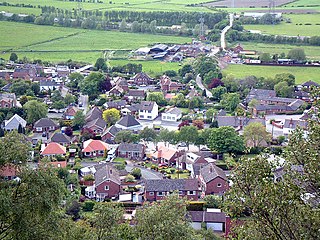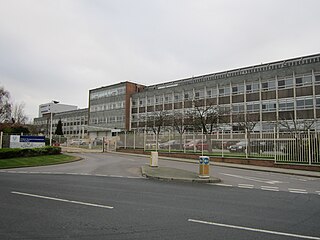
Ellesmere Port is a port town in the Cheshire West and Chester borough in Cheshire, England. Ellesmere Port is on the south eastern edge of the Wirral Peninsula, six miles north of Chester, on the bank of the Manchester Ship Canal. The town had a population of 61,090 in the 2011 census. Ellesmere Port also forms part of the wider Birkenhead urban area, which had a population of 325,264 in 2011.

The M56 motorway serves the Cheshire and Greater Manchester areas of England. It runs east to west from junction 4 of the M60 at Gatley, south of Manchester, to Dunkirk, approximately four miles north of Chester. With a length of 33.3 miles (53.6 km), it connects North Wales and the Wirral peninsula with much of the rest of North West England, serves business and commuter traffic heading towards Manchester, particularly that from the wider Cheshire area, and provides the main road access to Manchester Airport from the national motorway network.

The University of Chester is a public university located in Chester, England. The university originated as the first purpose-built teacher training college in the UK. As a university, it now occupies five campus sites in and around Chester, one in Warrington, and a University Centre in Shrewsbury. It offers a range of foundation, undergraduate and postgraduate courses, as well as undertaking academic research.

Tranmere Oil Terminal is situated on the River Mersey, 1.5 mi (2.4 km) south of Birkenhead. It was opened on 8 June 1960 to handle vessels of up to 65,000 tons, at two berths. It is connected to the Stanlow Oil Refinery by a 15 mi (24 km) crude oil pipeline. and a fuel oil pipeline. Part of the terminal occupies the site of a former ferry service to Liverpool, with the extant pier considerably modified.

Elton is a village and civil parish in Cheshire West and Chester, Cheshire, England, 13 km (8.1 mi) northeast of Chester, between Helsby and Ellesmere Port, near the River Mersey. Its proximity to the Mersey and the Manchester Ship Canal have contributed to its industrial character. The village is on the north-western edge of the Cheshire Plain, 2.5 km (1.6 mi) from Stanlow Refinery.

Knutsford Services is a motorway service station on the M6 in Cheshire, England.

Helsby is a village, civil parish and electoral ward in the unitary authority of Cheshire West and Chester and the ceremonial county of Cheshire, England. Overlooking the Mersey estuary, it is approximately 9 miles (14 km) north east of Chester and 2.5 miles (4 km) south west of Frodsham.

Buncefield oil depot is operated by Hertfordshire Oil Storage Ltd (HOSL) and officially known as the Hertfordshire Oil Storage Terminal. It is an oil depot located on the edge of Hemel Hempstead to the north of London in the United Kingdom (UK). In December 2005 a series of explosions on the site caused the largest fire in Europe since World War II.
The United Kingdom petroleum pipeline network is principally made up of three pipelines systems: the former Government Pipeline and Storage System (GPSS) now the Exolum Pipeline System; the Esso pipelines, and the United Kingdom Oil Pipelines (UKOP) and associated pipelines. There are also several other lines including the Fina line built around 1990 that runs from North Lincolnshire to the Buncefield oil depot near Hemel Hempstead.

Stanlow Refinery is an oil refinery owned by Essar Energy in Ellesmere Port, North West England. Until 2011, it was owned by Shell UK. The refinery is situated on the south bank of the Manchester Ship Canal, which is used to transport seaborne oil for refining and chemicals for Essar.

Stanlow and Thornton railway station is located within the Stanlow Refinery in Cheshire, England. It lies on the Hooton–Helsby line with services operated by Northern Trains. The station is surrounded by the refinery site, so as a result most station users are refinery employees. In 2018–19 it was the joint least-used railway station in Britain, tied with Denton in Greater Manchester. In 2020/21, the station was also one of the least used stations in Britain, with 0 entries/exits. Since 3 February 2022 the station has been temporarily closed due to safety concerns of the footbridge which is the only entrypoint to the station.

Ince & Elton railway station, on the Hooton–Helsby line, serves both Ince and Elton in Cheshire, England. The station is unstaffed.

Chester services is a motorway service area on the M56 motorway in Cheshire, England. The site is approximately 10 mi (16 km) from Chester city centre. Operated by Roadchef, it is the only motorway service area on the M56 and the last before heading into North Wales.
The Abbey of St. Mary at Stanlaw, was a Cistercian foundation situated on Stanlaw - now Stanlow Point, on the banks of the River Mersey in the Wirral Peninsula, Cheshire, England, near Ellesmere Port, 11 km north of Chester Castle and 12 km south-west of Halton Castle.

The Hooton–Helsby line is a railway line in the north-west of England that runs from Hooton on the Chester–Birkenhead line to the village and junction station at Helsby where it joins the Chester–Warrington line.

Plumley is a village and civil parish in the unitary authority of Cheshire East and the ceremonial county of Cheshire, England. It had a population of 643 at the 2011 census.

Coryton Refinery was an oil refinery in Essex, England, on the estuary of the River Thames 28 miles (45 km) from central London, between Shell Haven Creek and Hole Haven Creek, which separates Canvey Island from the mainland.

The Unilever Research & Development Port Sunlight Laboratory is the multinational consumer goods company Unilever's main research and development facility in the United Kingdom. It is located in Bebington, Merseyside.

The Sunbury Research Centre -- also known as ICBT Sunbury—is a main research institute of BP in north-east Surrey.
Heysham oil refinery was located between Heysham and Middleton on the Heysham peninsula, Lancashire. It was built during the Second World War to produce high octane fuel for combat aircraft. It was later adapted to refine crude oil with a processing capacity of two million tonnes per year and was in operation from 1948 to 1976. It worked in conjunction with a chemical plant which produced ammonium nitrate fertilizer and other products, using feedstocks from the refinery.


















